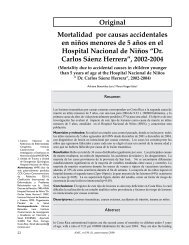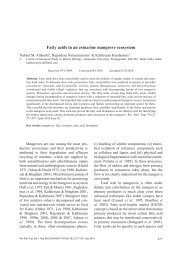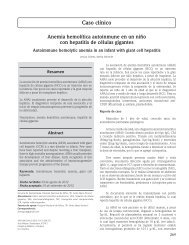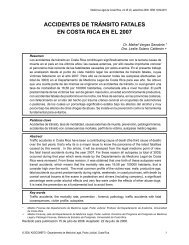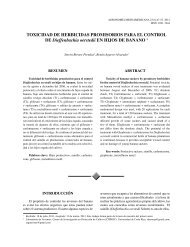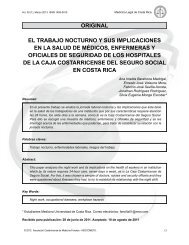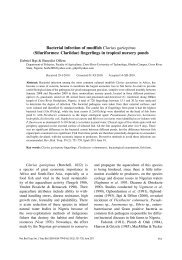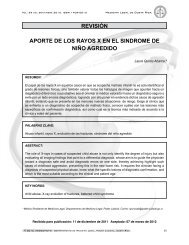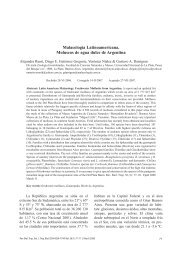how to prepare manuscripts - SciELO - Scientific Electronic Library ...
how to prepare manuscripts - SciELO - Scientific Electronic Library ...
how to prepare manuscripts - SciELO - Scientific Electronic Library ...
Create successful ePaper yourself
Turn your PDF publications into a flip-book with our unique Google optimized e-Paper software.
HOW TO PREPARE MANUSCRIPTS<br />
The Revista de Biología Tropical offers authors and readers:<br />
Stringent peer reviewing: The acceptance rate, close <strong>to</strong> 30%, allows a careful selection of<br />
papers by importance and subject. The two organs of evaluation and support, the Edi<strong>to</strong>rial Board<br />
and the International <strong>Scientific</strong> Board (see inside cover) have renowned world class experts.<br />
True international circulation: The printed version of the journal is found in libraries of 64<br />
countries where there is significant scientific activity. The journal is also available <strong>to</strong> millions of<br />
Internet users through the World Wide Web.<br />
High impact: If you consult anything from specialized papers <strong>to</strong> serious books on the<br />
Neotropics, you will frequently find the journal cited as the source of information, and it is<br />
included in key references such as Biological Abstracts, Zoological Record, Current Contents,<br />
Bulletin Signaletique, Scielo and Latindex.<br />
1. The journal is part of the “scientific mainstream” according <strong>to</strong> the Institute for <strong>Scientific</strong> Information and mantains<br />
a high level of quality by judging <strong>manuscripts</strong> solely on scientific merit. We encourage authors <strong>to</strong> suggest possible<br />
reviewers and <strong>to</strong> include copies of the opinion letters of colleagues who read the draft previous <strong>to</strong> submission.<br />
2. The journal discourages submission of unnecessarily subdivided reports of a single study. Similarly, the number of<br />
authors is expected <strong>to</strong> correlate with the amount of work required for the study.<br />
3. We will acknowledge reception as soon as your paper arrives. Manuscripts accepted for review by the Edi<strong>to</strong>rial Board<br />
will be sent <strong>to</strong> three internationally recognized specialists.<br />
4. Senior author will receive a journal copy and an electronic reprint (PDF) for academic distribution. Excess pages will<br />
be charged a fee. Submission of long monographs and supplements requires previous consultation with the Edi<strong>to</strong>r.<br />
Files are discarded three months after publication, we cannot accept responsibility thereafter.<br />
HOW TO PREVENT DELAYS<br />
Many <strong>manuscripts</strong> take longer <strong>to</strong> process because they do not follow the correct format. The<br />
easiest way <strong>to</strong> conform <strong>to</strong> our style is by studying the type of letter case, order of citations, format<br />
of references, tables and figure captions, etc. in a recent issue. If your manuscript looks like a<br />
published paper in this format (except for the use of two columns per page which you must NOT<br />
use), it is probably correct. Never underline words: use italics.<br />
Rev. Biol. Trop. (Int. J. Trop. Biol. ISSN-0034-7744) 305
You may print this checklist <strong>to</strong> make sure your manuscript is ready for submission.<br />
The manuscript has the following characteristics:<br />
❏<br />
❏<br />
It presents original biological information on tropical organisms and fits the following format.<br />
Detailed field study, done for more than a year, or in depth labora<strong>to</strong>ry study, about several<br />
related <strong>to</strong>pics; (range: 8 001-20 000 words).<br />
General instructions<br />
Follow the standard structure of a scientific<br />
paper (do not merge results with discussion)<br />
and include a note for the Edi<strong>to</strong>r <strong>to</strong> <strong>prepare</strong><br />
a Spanish Abstract (Resumen) if you cannot<br />
provide one.<br />
Submit the manuscript in .doc, .rtf or<br />
.pdf format <strong>to</strong> rbt@cariari.ucr.ac.cr<br />
<strong>to</strong>gether with an e-mail stating that<br />
the manuscript is original and that<br />
all authors agree with publication.<br />
Apply an au<strong>to</strong>matic spell checker, and state<br />
the <strong>to</strong>tal number of words at the foot of the first<br />
page. Send professional quality illustrations<br />
(300 dpi of resolution, 14 cm width and high<br />
definition images. Font captions in Times New<br />
Roman 16 points.<br />
❏<br />
❏<br />
Introduc<strong>to</strong>ry section<br />
The title is not capitalized throughout (only<br />
the appropriate letters), is short and includes<br />
Order and Family (botanical papers: only<br />
Family).<br />
Taxonomic authority (Author, year) for<br />
each taxon appears only once: in the main<br />
text, the first time the taxon is mentioned.<br />
Genera of binomials are written in full<br />
only the first time each is used, in the<br />
Abstract, main text, Resumen and keys.<br />
❏<br />
❏<br />
❏<br />
❏<br />
❏<br />
❏<br />
The address for correspondence is short but<br />
complete; if there are several, they must be<br />
numbered. Include e-mail for all coauthors.<br />
The Abstract (350-450 words) must<br />
describe the problem being addressed,<br />
<strong>how</strong> the study was performed, the salient<br />
results (often with means and sample<br />
sizes) and what the authors concluded.<br />
It must be a single paragraph. The same<br />
applies <strong>to</strong> the more succinct (200 words)<br />
Spanish Resumen, which can be added by<br />
the Journal upon request.<br />
Key words (five <strong>to</strong> seven) are separated<br />
by commas and will allow retrieval of the<br />
paper in the international databases featuring<br />
the journal.<br />
The Material and Methods section presents<br />
only the information required <strong>to</strong> repeat the<br />
study. Previously published methods are<br />
referenced and briefly described. Do not<br />
include a map of the study area; instead,<br />
provide the geographic coordinates.<br />
Voucher specimens must be deposited in<br />
at least one museum and the details and<br />
catalogue numbers given under Material<br />
and Methods. Normally, studies without<br />
vouchers are not accepted.<br />
Central part<br />
Quantitative data were evaluated with<br />
appropriate statistical tests, which are cited<br />
only after each result and in parentheses.<br />
306<br />
Rev. Biol. Trop. (Int. J. Trop. Biol. ISSN-0034-7744)
❏<br />
❏<br />
❏<br />
❏<br />
❏<br />
❏<br />
❏<br />
Example: Height and speed were correlated<br />
(Spearman, p< 0.05).<br />
Acronyms are spelled in full the first time.<br />
Units appear as follows: litres l, grams<br />
g, kilograms kg, seconds s, minutes min,<br />
hours hr, millimeters mm, centimeters cm,<br />
meters m, kilometers km; units are not<br />
capitalized and have no period. Decimals<br />
are indicated with a period, thousands and<br />
millions with a space. e.g. 12 523 235.15<br />
When not followed by units, integers from<br />
zero <strong>to</strong> ten are written in full (one, two<br />
etc., not 1, 2 etc.).<br />
Citations in the text are ordered chronologically<br />
and strictly follow the format<br />
of this example: (Smith 1978, Richards<br />
1982, 1985, Walker and Barnes 1992,<br />
Robbins et al. 2000). Note use of commas.<br />
For more than two authors, an italized et<br />
al. is used.<br />
Only cited publications appear under<br />
References and vice versa. Unpublished<br />
papers do not appear under References:<br />
they are mentioned in the text as in this<br />
example: (J. Smith, unpublished).<br />
FIGURES AND TABLES<br />
Isolated figures have been avoided by<br />
grouping related pho<strong>to</strong>graphs and illustrations.<br />
Symbols and scales appear as<br />
a caption in the figure (never as a footnote).<br />
Labels are at least 5 mm from the<br />
image border.<br />
Very long or very short tables have been<br />
avoided (half a page is a good size) and<br />
no vertical or horizontal lines have been<br />
used. All symbols and abbreviations used<br />
appear only in the footnotes.<br />
❏<br />
❏<br />
Final part<br />
Only persons who gave very significant<br />
assistance are mentioned by name under<br />
Acknowledgments. “Dr.”, “Prof.”, “Mrs.”,<br />
etc. are not used.<br />
References are ordered alphabetically<br />
and strictly follow this format, including<br />
details such as spacing, commas, underlining,<br />
capitals, etc.:<br />
Article<br />
Domínguez R., L.F., F. Zamora & G. Fuentes. 2005.<br />
Demography of the parasite Gnathos<strong>to</strong>ma binucleatum<br />
(Spirurida: Gnathos<strong>to</strong>matidae) during a ten year<br />
period. Rev. Biol. Trop. 53: 1235-1246.<br />
Book, report or proceedings<br />
Robinson, J.S. 2005. Icthyology. Winsley, New York, New<br />
York, EEUU. 1200 p.<br />
Chapter in multiauthored book<br />
Peters, W.H. 2005. Sediments, p. 7-41. In R. Smith & J.A.<br />
Mead (eds.). Tropical ecosystems. Van der Meet, The<br />
Hague, Holland.<br />
Thesis<br />
Stern, G. 2005. Evolution of DNA sequences in Netropical<br />
cambarids (Crustacea: Decapoda). Ph.D. Thesis,<br />
Uppsala, Sweden. 289 p.<br />
❏<br />
Internet references: If possible, avoid<br />
Internet references, they are considered<br />
less valuable than printed references, mostly<br />
because they dissapear easily. If you<br />
must use them, apply the same format of<br />
all other citations, e.g.: (Anonymous 2004).<br />
Rev. Biol. Trop. (Int. J. Trop. Biol. ISSN-0034-7744) 307
At the end of the References section, create<br />
a sub-section titled “Internet References”<br />
with the following format:<br />
Anonymous. 2004. Population genetics in tropical birds.<br />
Institute for Avian Research, Perth, Western Terri<strong>to</strong>ry,<br />
Australia. (Downloaded: December 23, 2005, www.<br />
iar.net.autropical.htm).<br />
NOTE: References with both paper and<br />
electronic versions are included in the standard<br />
references section, using the standard format,<br />
but you must add URL address, e.g.:<br />
Perez, J. & K. Smith. 2005. Ultrastructural correlations<br />
in tropical cambrian epifauna. Rev. Biol. Trop. 53:<br />
907-932 (also available on-line: www.tropiweb/53/2/<br />
perez.htm).<br />
NOTE: include publisher, city, state<br />
or province, and country; shorten printer’s<br />
name (e.g. write Wiley instead of Wiley and<br />
Sons Publications, Inc., do not write “Press”,<br />
“Verlag” and equivalent words). Do not state<br />
edition number.<br />
308<br />
Rev. Biol. Trop. (Int. J. Trop. Biol. ISSN-0034-7744)




